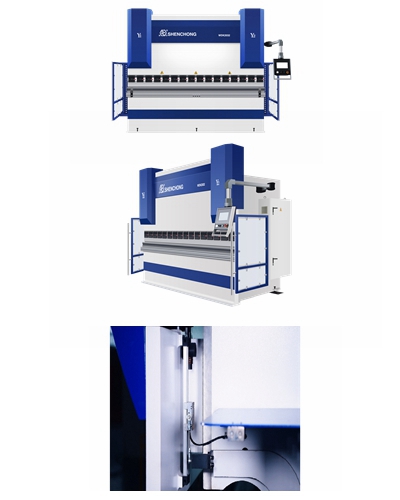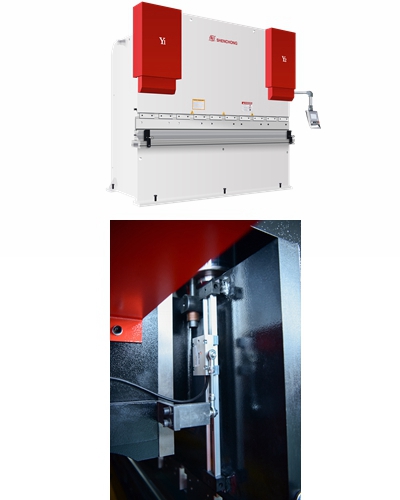
Press Brake magnetic ruler and grating ruler are often used in closed-loop servo system for detection of linear displacement or angular displacement. So how do they work? What's the difference? Which is better? We will make a detailed analysis to answer you one by one.

Magnetic ruler is a sensor made by using the principle of magnetic pole. The base ruler is a steel strip uniformly magnetized. The S-pole and N-pole are evenly spaced on the steel strip. It counts by reading the changes of S and N poles by the reading head.
Magnetic ruler is a linear displacement measurement scheme commonly used in the field of industrial automation equipment. Because of its strong durability and low environmental requirements, it has gradually replaced the optical linear measurement scheme with strict environmental requirements.
As a rare precision displacement detection scheme in the field of automation equipment, magnetic grid ruler is widely used. It is especially suitable for large machine tools with long detection stroke, high measurement accuracy and complex working conditions.
The magnetic scale is mainly composed of two parts: magnetic ruler and magnetic head.
Press Brake magnetic ruler is an important component structure of magnetic scale displacement sensor, which provides a reference for sensor displacement measurement and position positioning.
The magnetic reading head is a conversion device for magnetic and electrical conversion. It converts the magnetization signal recorded on the magnetic ruler into electrical signal and transmits it to the detection circuit to realize displacement measurement or position positioning. The magnetic reading head is also the key component of the magnetic grid ruler displacement sensor.
The magnetic head and magnetic ruler are read through non-contact installation, and the installation distance is 0.1-2mm. The NS - SN - NS poles on the magnetic ruler generate magnetic fields with different directions.
The read head senses the change of the magnetic field in the process of moving along the magnetic scale and converts the change of the magnetic field into an analog signal or a digital signal for output.
Its resolution is in the sub micron range, with high measurement accuracy and wide measurement range (up to 100m). Non contact installation, no wear.
The magnetic grid ruler has the advantages of convenient installation, strong anti-interference ability and strong impact resistance, and is not easy to be affected by vibration, dust, scale, oil stain, etc. High temperature and low temperature resistance are also outstanding.

Grating ruler displacement sensor is also called grating ruler and grating ruler sensor. It uses the optical principle of Moire fringe to measure and feedback the position movement of the object.
The grating scale is "read" by detecting the number of moire fringes. Then, the displacement and velocity of the object are calculated according to the action of the driving circuit.
The grating scale displacement sensor is composed of two parts: scale grating and grating reading head.
The press barke scale grating is generally fixed on the movable part of the machine tool, the grating reading head is installed on the fixed part of the machine tool. And, the indicating grating is installed in the grating reading head.
Grating ruler is a sensor made by using the principle of light interference and diffraction. Press brake grating ruler is often used in the closed-loop servo system of CNC machine tools. It can be used to detect linear displacement or angular displacement.
The measured output signal is digital pulse. It has the characteristics of large detection range, high detection accuracy and fast response speed.
The accuracy of grating ruler is relatively higher, about ± 0.005mm. However, it is greatly affected by temperature. Generally, the service environment is below 40 ℃. And higher requirements for the surrounding environment. The service life is relatively short.
The accuracy of magnetic grid ruler is relatively low, about ± 0.01mm. However, it has better water resistance, oil resistance, dust resistance and vibration resistance. Better adaptability to the environment. The service life is relatively long.
Grating ruler is good at accuracy. The measuring range has obvious advantages in cost performance in the range of 3 meters in length. Due to its production process, if the measurement length exceeds 5m, the grating ruler has high requirements for the working environment, and the production and manufacturing will be very difficult.
The magnetic ruler is good at resisting water, oil, dust and vibration. When the measuring range is more than 2m, its cost performance advantage is more and more obvious. Moreover, the longer the length, the more obvious the advantage. Its range can be up to 30 meters.
The open magnetic grid ruler is easily affected by the magnetic field. Closed magnetic grid ruler has no such trouble, but the cost is high.
SHENCHONG hydraulic press brake machine adopts high-quality linear magnetic grid ruler. It has high-precision guidance system and strong ability to resist oil pollution, vibration and other harsh environments. Position measurement system and hydraulic equalization function. It can meet the processing needs of full-length or eccentric bending.